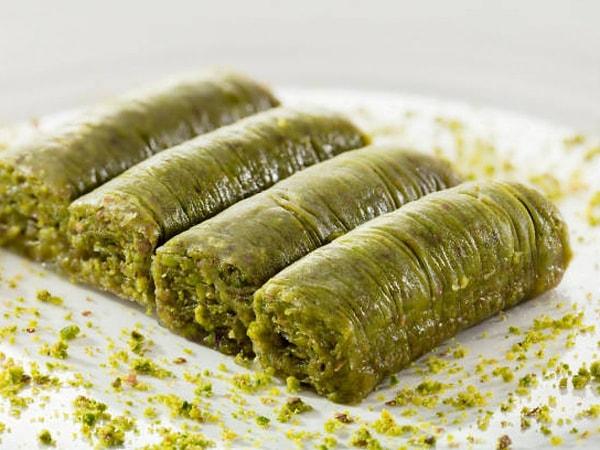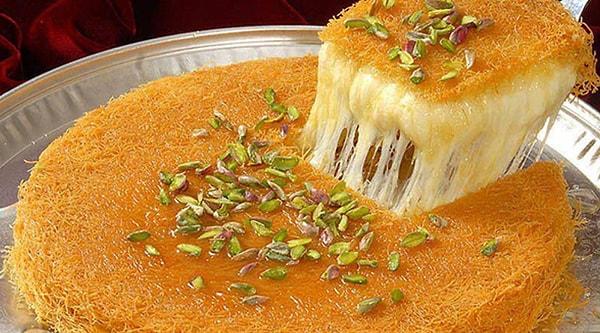Sweet Treats from Turkey: Discovering the Best Turkish Desserts
In this content, we will be exploring the best rated Turkish desserts that have captured the hearts and taste buds of dessert enthusiasts around the globe. Get ready to indulge in a symphony of flavors and textures as we uncover the sweet treasures of Turkish culinary heritage.
Tavuk Göğsü

Surprisingly, this traditional Turkish dessert made with chicken breast doesn't have a chicken taste at all. Instead, it is infused with delightful flavors of cinnamon and vanilla, resembling a velvety, creamy milk or rice pudding in both texture and appearance.
Originating from a medieval French dessert known as blancmange, tavuk göğsü has a fascinating history and was once a cherished delicacy served to the Ottoman sultans residing in the prestigious Topkapı palace. Today, it has become a beloved signature dessert in Türkiye and can be savored in coffeehouses throughout the country.
İrmik Helvası

İrmik helvası, a traditional Turkish dessert, is a delectable treat made from semolina, butter, sugar, milk, and pine nuts. While the ingredients may seem simple, creating the perfect irmik helvası requires skill and precision.
The process begins by stirring sweetened hot milk into the semolina, along with melted butter and pine nuts. This mixture is cooked until it reaches a delightful granular consistency. The irmik helvası is then served in individual bowls, sprinkled with a generous dusting of cinnamon and adorned with sautéed pine nuts for an added touch of flavor and visual appeal.
Fıstıklı Sarma

This delightful Turkish confection features a creamy and vibrant green filling called fıstık ezmesi, which can be likened to pistachio butter. It shares similarities with marzipan but offers a unique twist with the distinct flavor of Gaziantep pistachios, giving it a beautiful natural green hue.
To showcase the delicious pistachio paste, it is carefully wrapped within a single sheet of delicate phyllo dough. This wrapping technique helps hold the luscious filling intact, giving rise to two popular names for this type of baklava: fıstıklı sarma or fıstıklı dürüm, translating to pistachio wrap or pistachio roll.
The result is a treat that combines the buttery crispness of phyllo dough with the smooth and nutty sweetness of the pistachio filling. Each bite offers a delightful contrast of textures and a burst of rich pistachio flavor.
Bal Kaymak

A beloved Turkish breakfast classic, bal kaymak is a delectable pairing of kaymak, a creamy dairy delight akin to clotted cream, with a generous drizzle of honey. This irresistible dish is commonly enjoyed as a spread or a sweet dip, complementing the traditional Turkish breakfast spread.
Served alongside a piping hot cup of tea and an array of other breakfast delicacies, bal kaymak adds a touch of indulgence to the morning meal. It is traditionally savored by spreading it on bread, allowing the rich and velvety kaymak to meld with the natural sweetness of the honey.
While primarily a breakfast staple, bal kaymak can also make an occasional appearance as a dessert. Some variations may even feature a sprinkle of ground, chopped, or whole walnuts as a delightful garnish, adding a pleasant crunch and nutty flavor to the creamy and sweet combination.
Fırın Sütlaç

Fırın sütlaç, a traditional Turkish dessert, is a delightful oven-baked rice pudding crafted with a combination of water, milk, sugar, rice, and rice flour. This humble yet satisfying sweet treat is believed to have roots in the Ottoman culinary tradition.
While the classic rendition of fırın sütlaç features the fragrant essence of rose water, modern variations often infuse the creamy mixture with the comforting notes of vanilla. The result is a luscious and light dessert that captivates the palate.
To add a finishing touch, fırın sütlaç is carefully browned under a salamander broiler, creating a delicate caramelized crust that adds an irresistible depth of flavor. Before serving, it is commonly adorned with a sprinkling of ground cinnamon, which lends a subtle warmth and aromatic touch. Alternatively, some may opt for a garnish of chopped hazelnuts, offering a delightful crunch and nutty undertones.
Künefe

Kunāfah, a tantalizing Turkish dessert, is a harmonious combination of contrasting textures and flavors. This delectable treat features two layers of crisp and buttery shredded kataifi or knefe dough, enveloping a velvety cheese cream that delights the palate with hints of orange zest and cardamom. To enhance its sweetness, the kunāfah is generously soaked in a sugar syrup infused with the zesty tang of lemon juice and the delicate essence of orange blossom water.
In Turkey, künefe traditionally showcases Hatay, Urfa, or Antep cheese, adding a savory element that beautifully balances the sweetness of the dessert. To enhance its visual appeal and provide a delightful crunch, künefe is elegantly adorned with a sprinkling of pistachios. Best enjoyed while still warm, this dessert transports taste buds to a realm of cheese-filled pastry dreams.
Baklava

Baklava, a decadent and irresistible dessert, is a masterpiece of delicate layers of thin phyllo dough interlaced with a generous amount of finely chopped nuts, all bathed in a luscious and syrupy sweetness. This delectable treat has garnered a global following, transcending boundaries, cultures, and traditions, with various countries claiming its origin and craftsmanship.
With roots that trace back to the ancient Assyrians in the 8th century, baklava's journey across the region led to its adaptation and modification by the Greeks, who introduced the iconic thin sheets of pastry known as phyllo dough. While the Greeks left their mark on the recipe, it is widely believed that modern-day baklava finds its true origins in Turkey, where it evolved into the exquisite dessert known and loved today.
Kazandibi

Originating from the era of the Ottoman Empire, kazandibi is a delightful Turkish dessert known for its unique name, which translates to 'burnt bottom pudding,' referencing the caramelized layer that forms at the bottom of the pan during cooking. This delectable treat is crafted using a combination of butter, milk, rice flour, sugar, starch, and a touch of flavoring such as vanilla, rosewater, or ground mastic gum.
In Türkiye, kazandibi is traditionally served as delicate, thin ribbons that are artfully rolled, though it can also be enjoyed as thick squares. The burnt caramel topping lends a distinctive earthy flavor that beautifully complements the sweet and creamy interior, resulting in a harmonious balance of tastes and textures.
Gaziantep Baklavası

Gaziantep, the ancient Anatolian city formerly known as Antep, holds a prestigious title as Türkiye's culinary capital, renowned for its exceptional pistachios and the delectable Antep baklava. With its origins rooted in the Ottoman era, baklava stands as a testament to the artistry of the pastry chefs at Topkapı Sarayı, the grand imperial palace that housed Ottoman sultans from the 15th to the 19th century.
Traditionally, baklava was a cherished treat reserved for the joyous occasion of Eid-al-Fitr, also known as Ramazan or Şeker Bayramı in Türkiye, which commemorates the end of Ramadan, the holy month of fasting in Islam. Today, this Turkish delight is available throughout the year, captivating the taste buds of locals and visitors alike. Gaziantep, with its impressive array of over 500 baklava bakeries, serves as a haven for baklava enthusiasts. The city truly comes alive during the pistachio harvest season, spanning from midsummer to September, when the vibrant green nuts reach their peak size, perfect for adorning the layers of this beloved pastry.
Dondurma

The birthplace of Turkish ice cream is believed to be the city of Maraş, which lends its name to this unique treat. What sets Turkish ice cream apart from other varieties is its exceptional resistance to melting and its delightfully dense and chewy texture. These distinct qualities are achieved by incorporating two key thickening agents into the base mixture of milk and sugar: Arab gum, also known as mastic resin, and salep, a flour derived from the root of the early purple orchid.
In the Kahramanmaraş region, Turkish ice cream often contains a higher concentration of salep than usual, resulting in a thicker consistency. This is why it is sometimes referred to as kesme dondurma, meaning 'cuttable ice cream' in Turkish. It is customary to enjoy this particular ice cream variety with a knife and fork, highlighting its unique texture and allowing for a more leisurely and indulgent experience.
Keşfet ile ziyaret ettiğin tüm kategorileri tek akışta gör!


Send Comment